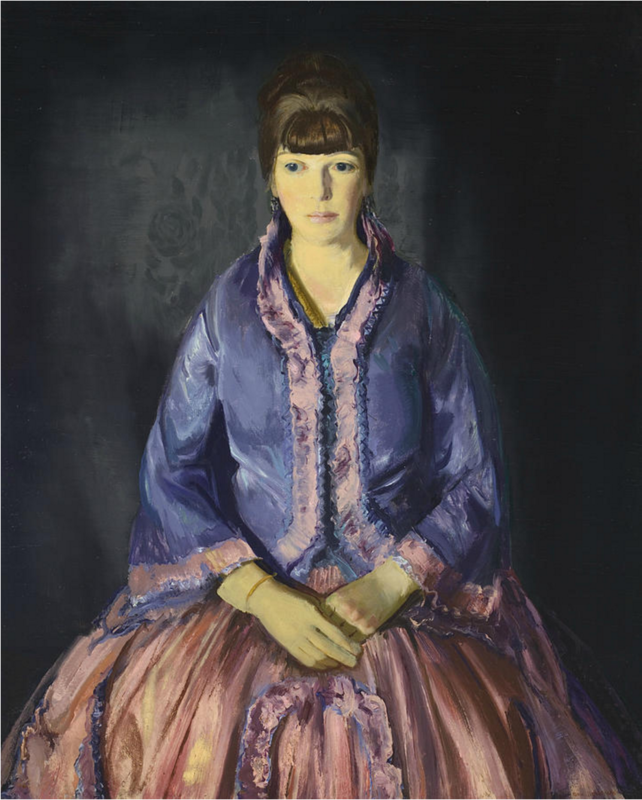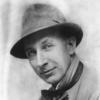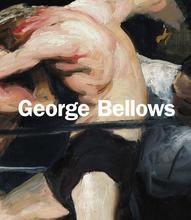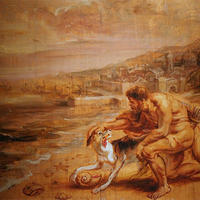More about Emma in the Purple Dress
- All
- Info
- Shop

Contributor
George Bellows switches between sports and fashion with ease in Emma in the Purple Dress.
George Bellows was a manly man. He learned to throw punches with boys as a child, he was an Ohio State baseball and basketball athlete, and he is known today for his paintings of boxing scenes. Ah, can’t you just feel the testosterone? They are expressive and exciting pictures, emphasizing force, movement, and the overwhelming human desire to overcome adversity.
In comparison, Emma in the Purple Dress is…different. It has none of those fist-pumping qualities of Bellows's more famous pictures and Emma, who was Bellows’ wife, looks crestfallen, like she’s been forced to wait for her flu shot at CVS. Despite looking slightly wistful, it’s important to note that Emma was a fiery woman who resisted Bellows’s advances for years before she agreed to marry him. He wrote her a lovesick puppy dog letter once stating, “Can I tell you that your heart is in me and that your portrait is in all my work? What can a man say to a woman who absorbs his whole life?” For her part, Emma chastised Bellows for asking her to pose for a portrait saying, “You had better make it snappy, this dress will not hold out much longer.” W-H-I-P-P-E-D.
So, poor Bellows had the very difficult task of capturing this spirited human being he loved and knew intimately, with all her hidden complexities and intricacies. At first, our eyes are obviously going to be drawn to her gown, which practically engulfs the space with a personality of its own. The dress is colorful, vibrant, and, most importantly, an extension of Emma herself. I mean, you can tell by George’s vivid brushstrokes that he died for this dye. This isn’t the sad and drab attire James McNeill Whistler depicted his poor mum wearing. Some might say that Bellows merely used Emma as a model to practice his artistic technique, but I highly doubt that. Even though Bellows paints Emma in an eye-catching gown, he gives her a soft and quiet expression, inviting us to wonder about her person. Her hands are purposely folded and her pensive eyes look away, exuding control, poise, and purpose. She carries an aura of strength in her appearance which, although not physically forceful, mirrors Bellows's other works in their shared resolve to elevate the individual. Emma must have inspired George because he focused more and more on portraiture after getting married, producing other portraits of her with their children. He is honestly so darn romantic that he should have just changed the title to "When A Man Loves a Woman."
Sources
- Adams, Dr. Henry. “Biography.” Accessed March 1, 2017 http://www.georgebellows.com/biography
- Comey, Janet. Museum of Fine Arts, Boston. “Emma in the Black Print.” Accessed March 1, 2017. http://www.mfa.org/collections/object/emma-in-the-black-print-33247
- Dallas Museum of Art. “Emma in the Purple Dress.” Accessed March 1, 2017 https://www.dma.org/collection/artwork/george-w-bellows/emma-purple-dre…
- Hudson, Mark, “George Bellows Profile: Artist of New York Life,” The Telegraph, March 15, 2013. Accessed March 1, 2017. http://www.telegraph.co.uk/culture/art/9901052/George-Bellows-profile-a…
- Los Angeles County Museum of Art. “Emma in the Purple Dress.” Accessed March 1, 2017 https://collections.lacma.org/node/214920
- Minneapolis Institute of Art. “Mrs. T. in Cream Silk, No.2.” Accessed March 1, 2017. https://collections.artsmia.org/art/1385/mrs-t-in-cream-silk-no-2-georg…
- Richman, Jeff. “George Bellows: New York’s Great Realist Painter.” December 8, 2012. Accessed March 20, 2017. http://www.green-wood.com/2012/george-bellows-new-yorks-great-realist-p…
- Smith, Roberta, “Restless in Style: ‘George Bellows,’ at the Metropolitan Museum of Art,” New York Times, November 15, 2012. Accessed March 1, 2017.
- The Metropolitan Museum of Art. “First Comprehensive Retrospective of American Artist George Bellows in Nearly Half a Century on View at Metropolitan Museum.” Last modified February 6, 2013. Accessed March 1, 2017. http://www.metmuseum.org/press/exhibitio
- The Metropolitan Museum of Art. “George Bellows.” Accessed March 1, 2017. http://www.metmuseum.org/exhibitions/listings/2012/bellows













